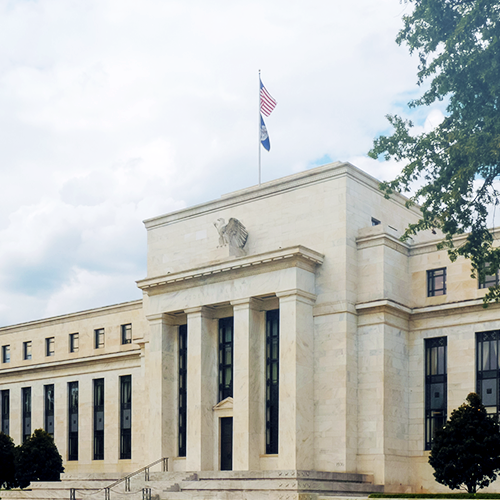.jpg)
August 2023
Behind the Trading Desk
An interview with Michael Lonia, head of trading for Aristotle Pacific Capital.
Download PDFWe recently sat down with Michael Lonia, head of trading for Aristotle Pacific Capital (sub-advisor to Aristotle Funds fixed-income funds), to talk about a day in the life of a trader, how trading in the bond market differs from equities, the importance of relationships, the differences between the new-issue primary and secondary markets, the trade process, what to watch for in the coming months, and how bond trading has changed over the past two decades.
Can you walk us through what a typical day as a bond trader looks like, especially on the West Coast?
I would say that there’s not necessarily a typical day, given that every day is unique as markets are constantly evolving. But as you mentioned, being on the West Coast adds a different wrinkle to what we do given the time difference. I’m usually in the office by 6 a.m. since the stock market opens at 6:30 a.m. Pacific time. A typical start to my day includes checking equity futures, reviewing economic releases that typically come out at 5:30 a.m. West Coast time, and then going through some of the macro headlines as well as some of the credit headlines of the day. And then we start to get into the primary and secondary markets for credit. Primary markets being new bonds that are issued that day, and then secondary being existing bonds. We review the outstanding orders that we have to see what’s executable. Then we have our morning meeting.
What does that meeting entail?
It’s an all-hands-on deck meeting that we have each morning at 7:30 a.m. Pacific time. That is headlined by reviewing the macroeconomic releases of the day, as those are pertinent to what we do in the credit markets. Then it’s open forum for the analyst portfolio managers and business teams to give their latest updates. It’s an important meeting for everyone to come together prior to the rush of the day to share thoughts.
How does trading in the bond market—particularly corporate bonds—differ from equity-market trading?
It’s very different trading a stock versus a bond. Stocks trade over listed exchanges; bonds trade over the counter. In bond trading, you need both parties to agree to a price to execute a trade. It’s much more hand-to-hand compared to equities. Also on the bond side, we’re dealing directly with brokers on the other side to agree to those prices where we transact. Brokers such as Goldman Sachs, J.P. Morgan, and Citi send out levels throughout the day that you can buy and sell bonds. They are constantly adjusting and moving those levels throughout the day based on market conditions. I’d also note another big difference between trading stocks versus bonds. The top three non-financial issuers in the Bloomberg Aggregate Bond Index (Agg) each have 46 to 48 individual bonds that are U.S. denominated. Plus, they also have multiple foreign currency bonds. If you compare that to the stock market, there’s one stock for each of those issuers.
How much do relationships matter when it comes to bond trading?
One of the key aspects of my job besides trade execution is ensuring that our relationships with the dealers are solid. It’s imperative for us to put in the work to maintain relationships and build relationships when the dealers have new personnel in the seats. These relationships come into play not only on the primary side with new-issue allocations and assist with getting our story in front of syndicate desks, but also on the secondary side working between us and the trader on the other side. When I first started, most of our trades were executed over the phone with a trader or a salesperson on the other side. But this has shifted to nearly entirely getting trades getting done over Bloomberg Chat or over electronic trading platforms. That’s definitely changed the dynamics with the relationships. But the thing that doesn’t change is the fact that the relationships are still very important.
Could you talk about more some of the differences between the secondary market and the new-issue primary market?
For the primary market, we have issuers bring new bonds to the market each day. If market conditions are strong, we tend to see a lot of issuance. And if we see market volatility and weaker conditions, we definitely see a lack of primary. The secondary market, on the other hand, is very consistent. The secondary market consists of existing bonds, and the volumes have definitely been very decent in the high-yield and investment-grade side. Just to put in perspective the volumes, high-yield daily volumes have averaged $13 billion in recent years. Investment-grade has been around $25 billion per day. If you put that in context from what we typically see on the primary side, we typically have high-yield primary issuance that is around $5 billion per week.
Can you go through a typical decision process for a trade?
We have different ways that the trades are sent into the trade desk. There are analyst-arrived ideas. The analysts come up with their own ideas on credits within their own sectors, and they review those with the portfolio managers to see if there’s an appetite to implement those trades in their portfolios. And then if the portfolio manager likes the idea, then they get sent to the trade desk, and I execute it. There are also portfolio manager-driven trades. There are times where they’re adjusting positioning, duration, or a strategy within a certain sector or maybe just broader across the entire portfolio. And then there are trade ideas that are derived from the trade desk. I and our trade assistants recommend trades—a lot of times swaps, so buying one security while selling another—to the portfolio-manager teams to see if they have appetite to execute those trades.
For corporate credit, what will you be watching closely over the next few months or even the next year?
I expect 2023 to be similar from a volatility standpoint to 2022. Elevated volatility used to bring about better liquidity in prior years, but it was actually the opposite in the last months of 2022, and it resulted in orders for high-yield and investment-grade taking a lot longer to execute. While those trades might have taken a couple days in prior years, it’s now taking a lot longer. That’s forced us to be more creative in finding pockets of liquidity in order to accomplish trade agendas across all the asset classes. I think especially on the high-yield side, we need more of a robust primary market to be able to really unlock some of the liquidity that’s needed to boost the cash bond trading. We’ve also had some dealers pulling back on some of their liquidity on the portfolio-trading side, so those are large lists that we utilize to execute some larger trades. We’ve noticed a pullback from some of the dealers in that trading vehicle as well. We’re keeping an eye to monitor that situation to see if it improves as the year unfolds.
Also, as we approach the terminal fed funds rate—whether at this current range of 5.25-5.5% or possibly slightly higher if the Fed raises again in the fall—one of the key focuses will be on the impact of funding costs to credit issuers at these levels. What is the impact on fundamentals from an issuer standpoint on paying elevated coupons on their debt in order to get deals priced in the currently higher yielding environment? Also on the leveraged loan side, what’s the coupon level that existing floating-rate debt is being reset at and the cost on the issuer. Furthermore, how open are issuers to coming to market to get deals done at these current rates rather than possibly waiting? We could see a slowdown in supply as issuers wait for a possible better entry point with lower rates if the Fed does indeed start cutting rates as many economists are predicting to occur in the middle of next year.
And then lastly, which has been the case in recent years, just the growth in electronic trading and the fact that we’ve had poor liquidity, it’s moved more volumes into these electronic-trading platforms. I’m watching to see if that trend continues. And we’re always on the lookout for new platforms to see if there’s better liquidity solutions for us for trading.
You’ve been trading fixed income for nearly 20 years now. What would you say has changed over the two decades?
My day-to-day operations for trading is a lot less conversational with the brokers than it was when I first started. So, I do miss having more of the personal touch, but the relationships are still there, and they still matter. It’s just a different way of communicating. The other thing that’s changed drastically from when I first started out is the liquidity. When I started, it was before the Dodd-Frank Act and Trade Reporting and Compliance Engine (TRACE) reforms. Both of those have had a dramatic impact on reducing the amount of liquidity in the credit markets. We’ve also had a massive amount of issuance in recent years, and a lot of the traders on the credit side have a lot of individual line items to keep track of now. Because of all this, liquidity has just been diminished dramatically in 20 years.
Definitions
The Bloomberg Aggregate Bond Index or "Agg" is a broad-based fixed-income index used by bond traders and the managers of mutual funds and exchange-traded funds (ETFs) as a benchmark to measure their relative performance.
A cash bond is when you post cash in order to fulfill your obligations. The advantage to the principal of a cash bond is a lower fee. Because reserves are essentially covered by the cash on hand, there is no need for funds to be readily available.
High-yield bonds (or junk bonds) are bonds that pay higher interest rates because they have lower credit ratings than investment-grade bonds.
Investment grade refers to the quality of a company's credit. To be considered an investment grade issue, the company must be rated at 'BBB' or higher by Standard and Poor's or Moody's.
Issuance or issuing bonds is a way for companies to raise money. A bond functions as a loan between an investor and corporation.
Liquidity refers to the efficiency or ease with which an asset or security can be converted into ready cash without affecting its market price.
Over-the-counter (OTC) is trading securities via a broker-dealer network as opposed to on a centralized exchange like the New York Stock Exchange.
The primary market is where new securities are issued for the first time.
The secondary market is where previously issued securities are traded between investors.
A syndicate desk is a group of people responsible for researching, marketing and pricing bonds, loans or stocks of companies.
The terminal federal funds rate is the ultimate interest rate level that the Federal Reserve sets as its target for a cycle of rate hikes or cuts.
Volatility is a statistical measure of the dispersion of returns for a given security or market index. In most cases, the higher the volatility, the riskier the security.
Any performance data quoted represent past performance, which does not guarantee future results. Index performance is not indicative of any fund's performance. Indexes are unmanaged and it is not possible to invest directly in an index. For current standardized performance of the funds, please visit www.AristotleFunds.com.
The views expressed are as of the publication date and are presented for informational purposes only. These views should not be considered as investment advice, an endorsement of any security, mutual fund, sector or index, or to predict performance of any investment or market. Any forward-looking statements are not guaranteed. All material is compiled from sources believed to be reliable, but accuracy cannot be guaranteed. The opinions expressed herein are subject to change without notice as market and other conditions warrant.
Investors should consider a fund's investment goal, risks, charges, and expenses carefully before investing. The prospectuses contain this and other information about the funds. The prospectus and/or summary prospectus contains this and other information and should be read carefully before investing. The prospectus can be obtained by visiting AristotleFunds.com.
Investing involves risk. Principal loss is possible.
Foreside Financial Services, LLC, distributor.



